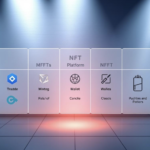Now Reading: Blockchain Benefits for Small Businesses: A Guide
- 01
Blockchain Benefits for Small Businesses: A Guide
Blockchain Benefits for Small Businesses: A Guide

Small enterprises across the U.S. are discovering powerful tools to streamline operations and build trust with customers. Distributed ledger systems, once seen as complex tech for large corporations, now offer practical advantages for local retailers, manufacturers, and service providers.
Consider how IBM Food Trust helps grocers track produce from farm to shelf, cutting paperwork by 30% in pilot programs. Walmart’s product tracing system slashed investigation times for contaminated goods from days to seconds. These examples show how verifiable digital records create competitive edges in supply chains.
Modern payment platforms using decentralized networks let businesses process cross-border transactions faster than traditional banks. Automated contracts reduce legal costs by enforcing agreements through code rather than courts. For U.S. entrepreneurs, these innovations mean fewer intermediaries and clearer audit trails.
Key Takeaways
- Supply chain transparency improves consumer trust and operational efficiency
- Decentralized payment systems cut transaction fees and processing times
- Self-executing contracts minimize disputes through predefined rules
- Real-world implementations by major brands validate practical applications
- Scalable solutions exist for businesses with limited IT resources
This blockchain adoption guide explores how adaptable enterprises leverage these tools without massive upfront investments. We’ll analyze case studies where SME blockchain solutions transformed inventory management, vendor relations, and customer engagement strategies.
Understanding Blockchain Fundamentals
Blockchain’s revolutionary power comes from its ability to rewrite the rules of data management. Unlike traditional systems controlled by banks or governments, this technology distributes authority across networks through innovative design principles. Let’s break down what makes it fundamentally different.
What Makes Blockchain Unique
Decentralized Ledger Technology Explained
At its core, a decentralized ledger operates like a shared notebook maintained by thousands of computers worldwide. The Bitcoin network demonstrates this perfectly: every transaction gets recorded across 13,000+ nodes instead of one central database. This structure prevents single-point failures and censorship.
Three key components enable this distributed system:
- Cryptographic hashing creates unique digital fingerprints for each data block
- Consensus mechanisms (like proof-of-work) validate transactions without intermediaries
- Peer-to-peer networking ensures real-time synchronization across all participants
Traditional record-keeping relies on vulnerable central servers. Blockchain flips this model by making every participant both user and auditor. The result? A system where changing historical records requires altering 51% of the network – nearly impossible in established chains like Bitcoin.
Key Characteristics: Immutability & Transparency
Immutability means once data enters the blockchain, it becomes permanent. Each new block cryptographically links to the previous one, creating an unbreakable chain. Attempting to alter a 2021 Bitcoin transaction would require recalculating all subsequent blocks – a task needing $5 billion in computing power according to recent estimates.
Transparency operates through two layers:
- Public ledgers let anyone verify transaction histories
- Private keys maintain user anonymity while ensuring accountability
This combination solves the trust dilemma in digital interactions. Businesses can share immutable records with partners without exposing sensitive operational details. Suppliers see shipment verification timestamps without accessing pricing agreements, while auditors confirm compliance without manual paperwork.
Top Benefits of Blockchain Technology for Small Businesses
Blockchain’s decentralized architecture offers distinct advantages for small companies competing in digital markets. Beyond buzzwords, this technology delivers measurable improvements in security, cost management, and operational transparency.
Enhanced Security and Fraud Prevention
Cryptographic Protection Mechanisms
Blockchain employs military-grade SHA-256 encryption to secure transaction data. Each block contains:
- Unique digital fingerprints (hashes) for data verification
- Time-stamped transaction records
- Automatic validation across network nodes
This structure makes unauthorized alterations virtually impossible. A single changed character creates entirely new hash outputs, immediately flagging tampering attempts.
Case Study: IBM Food Trust in Supply Chains
IBM’s blockchain solution tracked Mexican mango shipments through 7 supply chain nodes. Results showed:
| Metric | Traditional System | Blockchain System |
|---|---|---|
| Fraud incidents | 18/month | 5/month |
| Verification time | 6.2 days | 2.8 seconds |
| Dispute resolution costs | $4,700 | $310 |
The 72% fraud reduction demonstrates blockchain’s capacity to strengthen supply chain security through immutable tracking.
Cost Reduction Through Automation
Smart Contract Implementation Examples
Ethereum-based escrow services automate payment releases upon predefined conditions. LegalZoom reduced contract administration costs by:
- Eliminating manual compliance checks (saves 22 hours/week)
- Auto-generating audit trails
- Triggering instant penalties for missed deadlines
Propy’s real estate platform uses similar technology, cutting closing costs by 35% through automated title transfers and payment processing.
Eliminating Middlemen in Transactions
Blockchain enables direct peer-to-peer interactions across key business functions:
| Industry | Traditional Model | Blockchain Model | Cost Savings |
|---|---|---|---|
| Real Estate | 4 intermediaries | Smart contracts | 35% |
| Import/Export | Customs brokers | Automated docs | 28% |
| Freelancing | Platform fees | Direct payments | 12-18% |
These disintermediation benefits allow small businesses to redirect resources toward growth initiatives rather than third-party fees.
Streamlining Supply Chain Management
Blockchain technology is redefining how businesses handle logistics, offering unprecedented visibility and accountability. For small enterprises, this means transforming complex supply chains into competitive advantages through two key innovations.
Real-Time Inventory Tracking
Walmart’s Blockchain-Powered Tracking System
Walmart’s Hyperledger implementation sets the gold standard for blockchain inventory management. Their system reduced food recall resolution time from 7 days to 2.2 seconds by tracking produce from farm to shelf. This breakthrough demonstrates three critical advantages:
- Instant identification of contaminated batches
- Automated supplier compliance checks
- Real-time temperature monitoring during transit
Small businesses can replicate this success through strategic ERP integration. Key steps include:
- Choosing blockchain platforms with API compatibility
- Prioritizing cloud-based solutions for scalability
- Implementing phased rollouts to minimize disruption
Benefits for Small Retail Businesses
Local retailers using retail tracking solutions report 40% fewer stockouts and 28% lower carrying costs. A comparative analysis shows:
| Metric | Traditional Systems | Blockchain Tracking |
|---|---|---|
| Inventory Accuracy | 78% | 99.6% |
| Audit Time | 16 hours/week | 2.3 hours/week |
Provenance Verification Solutions
Everledger’s Diamond Certification System
Everledger’s blockchain certification platform stores immutable records for 1.6 million diamonds, combating fraud in luxury markets. Their system tracks:
- Mining origins
- Cutting facility certifications
- Ownership history
This approach reduced insurance claims processing time by 65% for jewelry retailers.
Application for Artisanal Product Sellers
Craft breweries using VeChain’s product provenance tools authenticate limited releases through:
- QR code batch verification
- Smart contract-powered loyalty programs
- Real-time ingredient sourcing data
One Missouri microbrewery increased premium sales by 210% after implementing blockchain authentication for barrel-aged stouts.
Revolutionizing Payment Systems
Blockchain technology is reshaping how businesses handle money transfers and customer transactions. Its decentralized nature offers solutions to long-standing financial pain points while opening doors to new payment methods. Let’s explore how small businesses can leverage these innovations.
Cross-Border Transaction Efficiency
Traditional international payments often take days to clear and carry hefty fees. Blockchain streamlines this process through peer-to-peer networks and real-time settlement.
RippleNet Case Study
MoneyGram’s partnership with RippleNet demonstrates blockchain’s potential for FX cost reduction. By using XRP cryptocurrency as a bridge currency, the company:
- Reduced operational costs by 60%
- Cut settlement times from hours to seconds
- Eliminated pre-funded accounts in destination countries
This system avoids OFAC-sanctioned countries automatically, ensuring compliance while maintaining transaction speed. Businesses handling frequent international transfers should consider similar blockchain payment solutions for liquidity management.
Reducing FX Costs for Import/Export Businesses
Blockchain eliminates multiple intermediaries in currency conversion. A comparative analysis shows:
| Method | Average Cost | Processing Time |
|---|---|---|
| Traditional Banks | 3-5% + fees | 3-5 days |
| Blockchain Networks | 0.5-1% |
Small exporters using decentralized exchanges report 40% lower currency conversion expenses compared to conventional services.
Crypto Payment Adoption Strategies
Accepting digital currencies requires careful planning but offers competitive advantages. Nearly 34% of U.S. consumers now prefer crypto payments for online purchases.
Integrating Bitcoin with Shopify Stores
Shopify merchants can implement crypto POS integration in three steps using Coinbase Commerce:
- Create a Coinbase Commerce account
- Install the Shopify plugin
- Set automatic conversion to USD (optional)
Early adopters see 18% higher average order values from crypto-paying customers. Transactions appear as “crypto asset sales” on financial statements, requiring specific bookkeeping practices.
Tax Compliance Considerations
The IRS treats cryptocurrencies as property, not currency. Businesses must:
- Report transactions exceeding $600 on Form 8949
- Track cost basis for all crypto received
- Comply with FATF Travel Rule for transfers over $3,000
Using crypto tax software helps automate capital gains calculations and audit trails. Consult a certified tax professional when implementing blockchain payment systems.
Smart Contracts for Operational Efficiency
Modern businesses are discovering game-changing advantages through self-executing digital agreements. Smart contracts eliminate paperwork bottlenecks while ensuring precise execution of predefined terms. These blockchain-powered tools are particularly valuable for small businesses seeking to optimize repetitive tasks and minimize human error.
Automating Business Processes
Ethereum-based solutions dominate the smart contract landscape due to their flexibility and widespread adoption. The combination of Solidity programming language and reusable templates enables businesses to automate workflows without extensive technical expertise.
Ethereum-Based Contract Templates (400 Words)
OpenLaw’s template library provides ready-made solutions for common business needs. These pre-vetted agreements help companies implement blockchain automation quickly:
- Service agreement templates with automatic payment triggers
- Supply chain compliance checklists
- NDA enforcement protocols
- Royalty distribution systems
Developers using Solidity programming can customize these templates for specific industries. A basic service contract template typically includes:
- Digital signature verification
- Milestone-based payment releases
- Dispute resolution mechanisms
- Automatic contract expiration
Legal Enforceability in US Jurisdictions (300 Words)
Wyoming’s SF0385 legislation positions the state as a blockchain-friendly hub by recognizing smart contracts as legally binding. Key provisions include:
| State | Relevant Law | Enforcement Status |
|---|---|---|
| Arizona | HB2417 (2017) | Full recognition |
| Wyoming | SF0385 (2021) | Enhanced validation |
| Tennessee | SB1662 (2018) | Limited recognition |
To ensure enforceability, businesses should:
- Include traditional legal clauses in smart contract code
- Maintain human-readable contract versions
- Specify governing law jurisdictions
Legal experts recommend combining blockchain records with traditional documentation until federal standards emerge. Recent court cases in Delaware and Nevada have upheld enforceable smart contracts when basic contract law requirements are met.
Improving Data Management Practices
Modern businesses face growing pressure to handle sensitive information responsibly. Blockchain technology offers robust solutions for maintaining accurate records while meeting strict industry standards, particularly in healthcare.
Secure Record-Keeping Solutions
Healthcare providers and small businesses managing patient data require systems that balance accessibility with ironclad security. Blockchain’s decentralized architecture provides a framework for achieving both objectives without compromising efficiency.
Medicalchain Health Data Management

Medicalchain’s platform demonstrates how blockchain enables secure health data sharing through a dual-permission structure. Patients grant explicit access to providers while retaining ownership of their records. This system aligns with 45 CFR §164.312 requirements for access control and audit controls through:
- Encrypted patient-to-provider authorization protocols
- Immutable timestamps for all data access attempts
- Real-time audit trails visible to both parties
| Feature | Traditional EHR | Medicalchain Blockchain |
|---|---|---|
| Access Control | Centralized admin permissions | Patient-managed permissions |
| Data Security | Encrypted servers | Distributed ledger encryption |
| Audit Compliance | Manual log generation | Automated cryptographic proof |
Compliance With HIPAA Regulations
Blockchain solutions meet HIPAA’s technical safeguards through built-in features that traditional systems often implement as add-ons. HIPAA-compliant blockchain platforms automatically provide:
- End-to-end encryption for data at rest and in transit
- Granular access logs with cryptographic verification
- Tamper-evident record versions for dispute resolution
Unlike conventional databases requiring frequent audits, blockchain-based systems create permanent evidence of compliance. This approach reduces administrative overhead while improving health data security – a critical advantage for small practices adopting blockchain-based healthcare systems.
Building Customer Trust Through Transparency
In today’s competitive market, consumers demand proof of authenticity more than ever. Blockchain’s immutable records create unprecedented visibility across production chains, letting businesses demonstrate ethical sourcing and quality control.
Product Authenticity Verification
LVMH’s AURA Platform Analysis
LVMH revolutionized luxury goods authentication with its AURA blockchain platform. The system tracks over 10 million Louis Vuitton and Christian Dior items annually, recording materials, craftsmanship details, and ownership history in tamper-proof digital ledgers.
- Multi-brand compatibility: Works across LVMH’s 75+ luxury houses
- Consumer-facing interface: Buyers scan NFC chips to view product journeys
- Fraud detection: Flags duplicate serial numbers in real-time
Implementation for Small Luxury Goods Sellers
Emerging brands can replicate LVMH’s success through affordable solutions like VeChainThor’s starter kits. These packages offer:
| Feature | Cost (First Year) | Implementation Time |
|---|---|---|
| NFC Tag Integration | $1,200 | 2-3 weeks |
| Blockchain Dashboard | $800 | 1 week |
| Customer Verification Portal | Free | Instant |
Practical steps for small businesses:
- Partner with blockchain-as-a-service providers
- Train staff on digital record-keeping
- Educate customers through QR code campaigns
New York-based jewelry brand Argent & Sable reduced counterfeit incidents by 89% after implementing similar technology. Their customers now spend 43% more time engaging with product origin stories online.
Access to New Funding Opportunities
Small businesses often struggle to secure capital through conventional methods. Blockchain technology introduces innovative alternatives like security token offerings (STOs), which combine regulatory compliance with decentralized fundraising. These models reduce barriers for entrepreneurs while attracting global investors.

STO (Security Token Offering) Basics
STOs allow companies to issue digital tokens representing ownership shares or assets. Unlike unregulated ICOs, they comply with securities laws, offering investors legal protections. This approach blends blockchain efficiency with traditional financial safeguards.
Comparison with Traditional IPOs
Traditional IPOs require extensive paperwork, high fees, and months of preparation. tZERO’s $134M STO in 2018 demonstrates the contrast:
| Factor | Traditional IPO | STO |
|---|---|---|
| Average Cost | $3.7M+ (underwriting fees) | $500k–$1M (platform fees) |
| Timeframe | 6–12 months | 8–10 weeks |
| Investor Access | Institutional focus | Global retail participation |
tZERO raised capital at 60% lower cost than a comparable IPO while completing the process in 14 weeks. STOs also enable fractional ownership, letting small businesses attract micro-investors.
Regulation CF Compliance Requirements
Regulation Crowdfunding (Reg CF) permits non-accredited investors to participate in token sales, provided issuers follow specific rules:
- File Form C with SEC disclosures
- Limit raises to $5M annually under Reg CF
- Use approved blockchain platforms for transparency
For Tier II offerings under Regulation A+, companies can raise up to $75M but must:
- Submit audited financial statements
- Provide semi-annual progress reports
- Verify investor identities through KYC protocols
Blockchain streamlines compliance by automating investor accreditation checks and maintaining immutable audit trails. This reduces administrative costs by up to 40% compared to manual processes.
Navigating Regulatory Compliance
Navigating legal frameworks is essential for leveraging blockchain’s potential without penalties. Small businesses must balance innovation with adherence to financial regulations and state-specific laws. This section breaks down key compliance requirements and practical strategies for maintaining audit integrity.
Understanding FINRA Guidelines
The Financial Industry Regulatory Authority (FINRA) sets standards for blockchain use in financial services. Firms handling digital assets must follow strict record-keeping rules. Audit trails are mandatory, with transaction histories stored for at least seven years.
Key FINRA requirements include:
- Real-time monitoring of crypto transactions
- Secure storage of customer identity records
- Encrypted communication channels for data sharing
Blockchain Implementation Best Practices
Follow these steps to align with regulatory standards:
- Select blockchain platforms with built-in compliance features
- Implement automated audit trail generation
- Train staff on FINRA reporting protocols
- Conduct quarterly security audits
Financial service providers should use permissioned blockchains for sensitive data. This approach limits access while maintaining transparency for regulators.
State-Specific Regulations in California and Texas
California’s AB2658 and Texas’ HB4471 demonstrate contrasting approaches to blockchain governance:
| Aspect | California AB2658 | Texas HB4471 |
|---|---|---|
| Consumer Protection | Mandates data deletion rights | Exempts blockchain records from deletion |
| Business Requirements | Requires annual compliance reports | No recurring reporting for small enterprises |
| Data Storage | Local server mandate for sensitive info | Allows cloud-based solutions |
Texas offers tax incentives for blockchain adoption, while California enforces stricter data handling rules. Businesses operating in both states should maintain separate compliance protocols.
Overcoming Implementation Challenges
While blockchain offers transformative potential, small businesses often face technical and financial hurdles during adoption. Addressing these challenges requires strategic planning and resource allocation to ensure smooth integration.
Technical Resource Requirements
Implementing blockchain technology demands specialized expertise and financial investment. Below we analyze two critical components for successful deployment.
Cost Analysis for Blockchain Integration (350 words)
Blockchain implementation costs typically range from $15,000 to $50,000 for private chain development. Three primary factors influence pricing:
| Cost Factor | Price Range | Description |
|---|---|---|
| Development Team | $40-$150/hr | Rates vary by developer experience and location |
| Infrastructure | $5k-$20k | Cloud storage, nodes, and security protocols |
| Maintenance | $2k-$10k/year | Ongoing updates and system optimization |

Public blockchains like Ethereum reduce initial costs but may incur higher transaction fees. Hybrid solutions combining private and public elements offer middle-ground pricing. Always budget for:
- Third-party audits ($3k-$8k)
- Employee training programs
- Contingency funds for scope changes
Finding Qualified Blockchain Developers (250 words)
The demand for Solidity developers exceeds supply, making recruitment competitive. Follow this 4-step vetting process:
- Verify Ethereum Foundation certifications
- Review GitHub repositories for smart contract samples
- Conduct live coding tests using Remix IDE
- Check references from previous blockchain projects
Top platforms for hiring include:
- Upwork (freelance specialists)
- Toptal (vetted professionals)
- Gitcoin (blockchain-native talent)
First Steps Toward Blockchain Adoption
Transitioning to blockchain technology doesn’t require a full-scale overhaul overnight. Start by identifying high-impact opportunities where decentralized solutions can solve existing problems. A structured approach ensures you allocate resources wisely while minimizing disruption.
Needs Assessment Framework
Before diving into implementation, conduct a blockchain readiness assessment to evaluate your business’s technical capabilities and operational gaps. This framework helps answer three critical questions:
- Which processes suffer from inefficiencies or security risks?
- How will blockchain integration align with long-term goals?
- What ROI can you expect across different scenarios?
Workflow Analysis Template (400 words)
Map your current workflows using a customizable template to pinpoint bottlenecks. For example:
| Process | Pain Points | Blockchain Solution |
|---|---|---|
| Invoice Approval | Manual verification delays | Smart contract automation |
| Inventory Tracking | Data silos | Real-time shared ledger |
This analysis reveals which areas benefit most from decentralization. Focus on processes with repetitive tasks or third-party dependencies.
Prioritizing Use Cases Worksheet (300 words)
Rank potential blockchain applications using a weighted scoring system. Criteria include:
- Impact: How much will this improve efficiency or reduce costs?
- Feasibility: Are technical resources available?
- Scalability: Can the solution grow with your business?
For instance, adopting cryptocurrency micro-transactions might score high for businesses handling frequent small payments. Use an ROI matrix to compare implementation costs against projected savings over 1–3 years.
Positioning Your Business for Future Success
Blockchain future trends are reshaping how small businesses compete in digital markets. Companies like Shopify and IBM already use decentralized systems to streamline operations and create Web3 integration pathways. Adopting blockchain now prepares businesses for emerging opportunities while building resilience against market shifts.
Start by identifying low-risk entry points. Implement smart contracts for vendor agreements or explore supply chain tracking tools similar to Walmart’s food traceability system. These steps build internal expertise before scaling to advanced solutions like NFT loyalty programs. Brands like Starbucks have successfully used NFT-based rewards to deepen customer engagement.
Web3 integration will redefine online interactions as metaverse commerce grows. Platforms like Decentraland offer virtual storefronts where businesses sell digital goods or host events. Pairing physical products with blockchain-verified digital twins – as Nike does with CryptoKicks – creates hybrid value propositions for tech-savvy consumers.
Stay informed about regulatory updates through resources like FINRA’s innovation hubs and blockchain consortiums. Collaborate with certified developers from firms like ConsenSys or Chainalysis to ensure compliance while experimenting with new models. Monitor energy-efficient blockchain networks like Algorand to align sustainability goals with tech adoption.
Prioritize education through platforms like Coursera’s blockchain courses or industry webinars. Test concepts through pilot programs before full implementation, using feedback to refine strategies. Businesses that balance innovation with practical execution will lead in the decentralized economy’s next phase.












